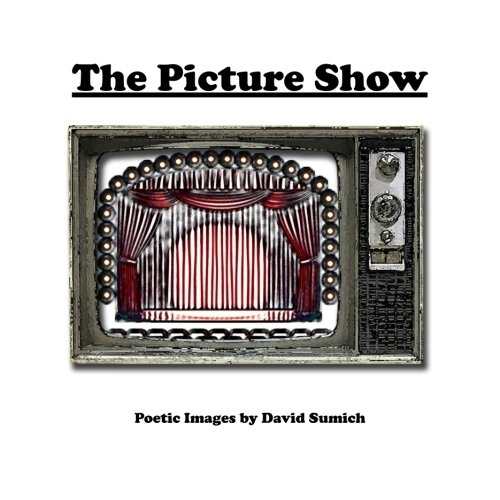The Picture Show
Poetic Images
Sumich’s collection draws surprising connections between images and verse.
David Sumich’s The Picture Show is a unique blend of verse and graphic art. Holding to a strict structure and narrow rhyme schemes, poems explore the uncertainties inherent in relationships. They simultaneously comment on and are informed by their associated images.
The book is composed of forty-eight two-page spreads, alphabetically arranged by the pieces’ titles. On one page is a poem, invariably composed of three stanzas of four lines each, and on the facing page is a color image that combines multiple layers of shapes, faces, and snippets of text into striking, textured patterns.
Rhyme is an important element in all of the poems, although rhyme schemes vary between and even within poems. For instance, in “Autumn,” the last word of every line rhymes within the first and last stanzas, while the middle stanza has an aabb pattern; elsewhere that might be abab or aaba. Only in a few places, as in “Fantasia,” do the specific rhymes edge toward the cheesy.
The poems often use contradictions and plays on words to delve into the complications of romantic love. The relationships depicted range from erotic to destructive. In “Snow White,” a cruel woman toys with the protagonist, while in “Songs of Silence,” vocabulary suggests sadomasochism—“switch,” “slave,” “Master’s,” and “pain” all factor in.
The narrator often wonders whether to stay or leave, and hopes that their object of desire will still be waiting. In a few places, romantic language is more clichéd, praising a lover’s expressive eyes and electric presence. In general, though, the book draws on a wide array of metaphors. The three stanzas of “Music Notes” consider rhythm, melody, and harmony in turn, using these elements as symbols of how valuable differences between individuals can be joined in interpersonal connections.
Likewise, the image of a melting pot in “Linear Equation” shows a pair of lovers transcending emotional and racial differences. Sometimes a featured image provides the overarching symbol, like in “Crawling Home,” which is illustrated with a snail that has a heart-shaped shell.
Some images resemble older computer clip art, as with the chess set illustrating “Cravings,” and the male and female outlines opposite “Ms. Sparkle.” The book’s comic font doesn’t fit with its usually serious subject matter, and grammatical and punctuation errors are a point of distraction.
At its best—as in “9 Lives,” where a Warhol-like panel of black cat silhouettes is overlaid on drawings of Technicolor pinups to evoke the term “sex kitten”—the book surprises with its unexpected connections between image and verse.
Sumich’s The Picture Show is an attention-grabbing set of poems and graphics that will hold particular appeal for those who like pop art.
Reviewed by
Rebecca Foster
Disclosure: This article is not an endorsement, but a review. The publisher of this book provided free copies of the book and paid a small fee to have their book reviewed by a professional reviewer. Foreword Reviews and Clarion Reviews make no guarantee that the publisher will receive a positive review. Foreword Magazine, Inc. is disclosing this in accordance with the Federal Trade Commission’s 16 CFR, Part 255.

